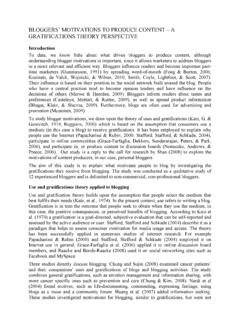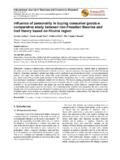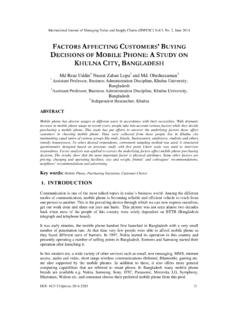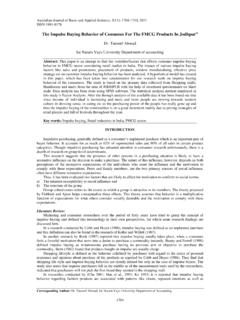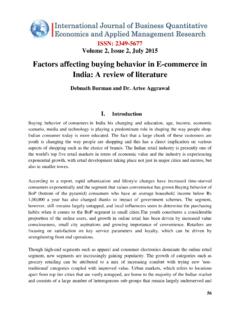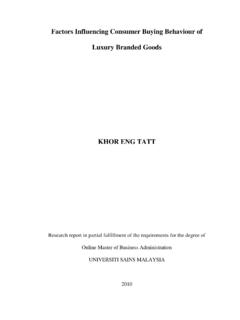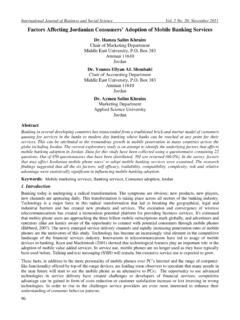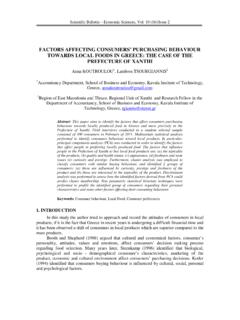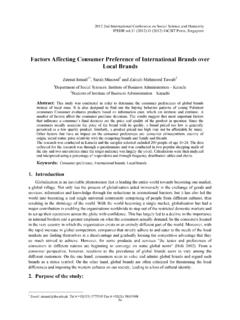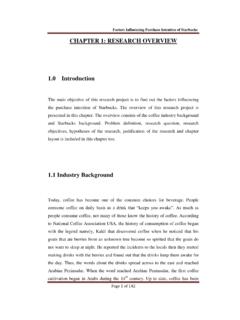Transcription of Consumer Behaviour in Fitness Centres: a Typology of …
1 1 Consumer Behaviourin Fitness Centres: a Typologyof CustomersIntroduction / purposeKnowing your customers and being able to provide what satisfies them is a critical issue fortoday s service providers and at the core of today s marketing ofconsumerbehaviour helps in effective segmentation and in creating successful service , Consumer Behaviour variesacross industries and is considered to bemulti-dimensional(Zeithamletal., 1996).Many researchers have investigated the effect of variousfactors, such as service quality; customer satisfaction; perceived service value, and cost ofservices on Consumer Behaviour in different industries includingbanks;fast-foods;drycleaning; athletic services; entertainment; thematic parks, and health institutes (Cronin&Taylor, 1992; Kelley at al.)
2 , 1993;Croninetal., 2000;Butcher et al., 2002;Bigneetal., 2005)In athletic services, research has focused on service quality and customer satisfactiondimensions and how these affect current and potential behavioural intentions (Parasuramanetal., 1994; Wakefield & Blodgett, 1994; Theodorakis & Kambitsis, 1998;Baker & Crompton,2000; Kostaetal., 2003;Kouthouris & Alexandris, 2005). Infitnesscenters,Papadopoulos etal. (2004) conclude that there is a strong relationship betweenallservicequalitydimensionsand positive word-of-mouth communications of customers whereas Afthinos et al.
3 (2005) findthat demographic factors such as gender affect perceived service quality customerexpectations of services, and therefore influence Consumer , Wang et al. (2008) seek to analyseconsumer Behaviour in Fitness centres andconclude that most customers belong to the18-35 36-55agecategories although maturecustomers are increasing rapidly. Also,they find thatcustomers tend to bemore educated andthe % of students is increasing. Majorcustomermotivesfor becoming members in a fitnesscentreinclude trainingand staying fitas well ,customers choosefitness center based oncriteria such ascost;quality ofenvironment; building, and equipment;group exerciseprogram content, andquality of this study provides somedeeper insights regarding the way consumers behave in Fitness centres, there is a need toanalyse further this Behaviour .
4 Therefore, the objective of this study is toanalyze consumerbehaviour in fitnesscentres. In detail, we aim to study consumers profile (demographic andpsychographic); theirmotives for becoming members in a fitnesscentre; the selection criteriathey use;theirusagebehavior in the fitnesscentre;the factors that affect their satisfactionfrom the fitnesscentre, and their future behavioural intentions regarding the study is descriptivein natureintending to describe the way consumers behave in a donebased on a structured questionnaire that was personallyadministered to apurposive sample of 350 respondents from 12fitness centres that are basedin three different cities in sample included different sizes of Fitness centres inorder to cover for different environments.
5 The questionnairewas divided into6 sections,namely Consumer motives; selection criteria; factors affecting satisfaction; Behaviour in thecentre s area;behavioural intentions;demographic & psychographicinformation. Theanalysis of the data included descriptive statistics, factor analysis andanova. The only scalesused from prior research are for the factorsthataffect customer satisfaction (Kim Kim,1995) andforbehavioural intentions (Zeithaml et al., 1996;Theodorakis & Kampitsis, 1998,and Theodorakis et al., 2000).2 ResultsResultsshowthatrespondentsare61% women and 39% men,most of them(45%)belong tothe 24-35 age categorywhereas32 are from 36-50 years old.
6 Almost half of the samplehas abachelor s degree(43%). The majority of respondents are not married (62%) and theirincomelevel is mostly (43%) between are employed as privateemployees(40%),civil servants(26%),or free professionals(19%). Also,there are a lot ofstudentsmembers of Fitness centres(10%).The most important Consumer motive to become a member of a Fitness centre is to enhancetheir Fitness state followed by relaxation stress reduction (see Table 1 for mean scores foreach motive).Table 1. Motives to become a member of a Fitness centreMotivesMeanEnhance Fitness *Relaxation stress body body *Likert scale from 1= not important to 5 = very importantTheselection criteriacustomers use to choose Fitness centre belong to four major groups (asdetermined by factor analysis on larger list):quality of environment & equipment;supplementary benefits suchas massage, solarium or hair-styling.
7 Value for money aspects ofthe offer (opening hours prices quality of personnel), and socialfactors (social relations topersonnel, friends already members etc.) Table2 shows the number of items and theCronbach a for each scale).Table 2: Fitness centre choice criteriaFactorsNoof itemsCronbachaQuality of environment- for money aspects of the offer(opening hours prices quality of personnel,) benefits( power plate, massage, hair styling, sauna) factors(social relations to personnel, friends alreadymembers etc) the sample is dominated by women, 82% use weights whereas only 54% take partin group workout use aerobic equipment and weights very often andmany times they do what trainers tell them whereas they work outin groups less often (seetable 3 for means of usagebehaviour).
8 A large50%work outfrom 1 to hours and36%from to 2 ,56% come tothe centre from up to and94% visitthecentrefrom2to5 times per than half of respondents (55%) are members ofthefitness centreformore than 1 year whereas 38% are members for more than 2 3:Usage behavior in thecentreFactorsMeanAerobic equipment (running belts, bicycles etc.) * trainers tell depending on my exercise *Likert scale from 1= never to 5 = very oftenAll categories of factorsthat affect satisfactionare important according to respondents as it isshown in Table 4. However, the most important ones concern the quality of personnel and thequality of environment of the Fitness 4:Factors affecting satisfactionin the Fitness centreFactorsMeanQuality of personnel factors4 Quality of environment , reliability and organisation *Likert scale from 1=not important at all to 5 = veryimportantInbehavioural intentions, we must note that the most important intention is word-of-mouthcommunication.
9 Most respondents are willing to provide positive word of mouth for theirfitness centre and are quite committed to their supplier in terms of purchase intentions nowand in the ,most respondentsare not very price sensitive andtheircomplainingintentions are low (see table 5 for means for each type ofbehavioural intentions).Table 5:Behavioural intentionsFactorsMeanWord of mouth communication4,6 Complaining intentions3,2 Purchase intentions (now and in thefuture) *Likert scale from 1=extremely unlikelyto 5 =extremely likelyFactor analysis on psychographic factorsshows that there are 4 types of customers in fitnesscentres, the Sports-savvy Consumer (6 items, a= 0,695); the Health-oriented Consumer (3items, a= 0,767); the Athletic Consumer (3 items, a= 0,668)and the Pressured Consumer (3 items, a= 0,6).
10 Further analysis with an aim to describe these 4 types of customers in termsof Behaviour revealed that the different groupshave different motives;use differentselectioncriteria, andbehave differentlyin the centre. Also, theirsatisfaction is affected by differentfactors, andexhibit differentbehavioral intentions(see table6 for a description of each typeof customer identified. In motives; selection criteria, and factors affecting satisfaction, the twomost important in each case appear in the table in order of importance).4 Table6: Types of customers of Fitness centres and their profileSports-savvyconsumerHealth-orient edconsumerAthletic consumerPressured consumerCharacte-risticsLike to wear athletic clothingRead sports mediaKeepinformed of Fitness trendsFollow an ahtletic way of lifeHave been involvedinsportsasamateurs/professionals Have a specific dietOften followdietsHave a healthy lifestyleViewexercise as funConsider exerciseas away of lifeDevote their free time toother forms of exercise( cycling, swimming).
